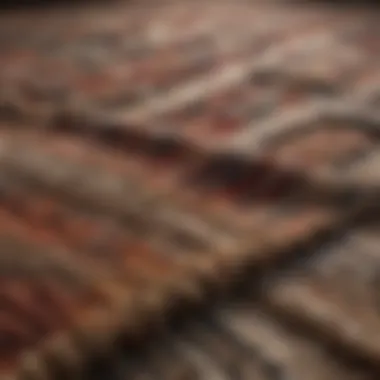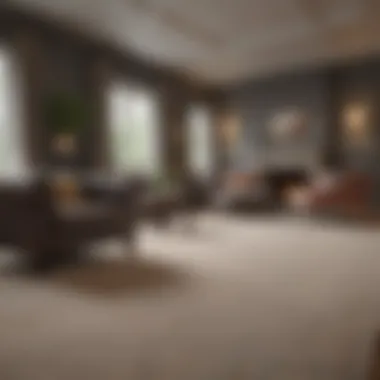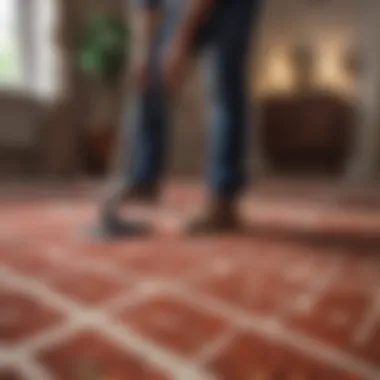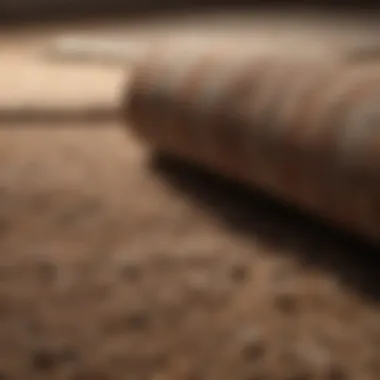Understanding Carpet Installation Costs: Key Factors


Intro
When contemplating carpet installation, homeowners often overlook the intricate ramifications of the overall expense. The cost considerations are not merely confined to the price per square foot of the carpet itself. Rather, they extend into various avenues including material selection, labor charges, and ancillary costs such as removal of old flooring or preparation of the subfloor. This discourse aims to outline these critical factors, so that both professionals and homeowners can navigate through the ups and downs of flooring choices and make informed decisions.
Each element in the process contributes to the total expenditure, and understanding their interplay is vital for effective budgeting. In the forthcoming sections, we will delve into the nuances of material types, labor rates, and additional financial implications that arise during carpet installation.
Design Inspiration
While cost is a primary focus, aesthetic considerations cannot be disregarded. Homeowners should explore various design inspirations as they select carpet for their space. This not only enhances the beauty of the room but also aids in creating a cohesive look.
Trending Styles and Themes
Carpet styles evolve continuously, reflecting current trends and consumer preferences. Popular themes include:
- Contemporary: Focuses on minimalism and functionality using neutral tones and subtle patterns.
- Traditional: Often features intricate designs and rich, warm colors, suitable for classic interiors.
- Transitional: Blends elements from both contemporary and traditional styles, ideal for homes with diverse decor.
Creating an inviting atmosphere while considering cost is essential. Select a style that resonates with personal aesthetic but also works with budget constraints.
Color Palettes and Combinations
Choosing the right color palette is essential in ensuring that the carpet fits well within the broader design theme of the room. Recommended color choices are:
- Neutral tones such as grays, beiges, or whites that provide versatility.
- Bold colors or patterns to make a statement, keeping in mind that these can be more challenging to match with furniture.
- Natural hues inspired by nature can create a calming environment, aiding in a restful atmosphere in areas like bedrooms.
Closure
The design decisions surrounding carpets significantly impact installation costs, but they should be carefully balanced with budgetary constraints. By effectively understanding the trends and making thoughtful choices, homeowners can achieve both aesthetic pleasure and financial sense.
Prolusion to Carpet Installation Costs
Understanding the costs involved in carpet installation is essential for any homeowner or professional involved in interior design. This stage of home improvement can seem overwhelming, but grasping the expenses can greatly ease the decision-making process. Carpeting is a significant investment, often affecting both the aesthetic and functional aspects of a space. Therefore, it is crucial to have a clear understanding of the financial implications before laying down that new carpet.
Key Elements to Consider
When tackling the costs of carpet installation, several elements come into play:
- Material Costs: Different types of carpeting come with varying price tags. Knowing your options allows you to select a material that fits both your style and budget.
- Labor Fees: Labor costs can vary widely depending on the installation complexity and the installer’s expertise. Understanding these rates will help you evaluate your overall budget.
- Hidden Costs: Often overlooked, factors like disposal of old carpet, underlayment needs, or even moving furniture can inflate final bills.
Benefits of Understanding Costs
By diving deep into the cost aspects, homeowners can avoid financial surprises later on. Establishing a clear budget prevents overspending and allows for better allocation of funds across different areas of your home project. It also provides leverage when negotiating with installers or suppliers, ensuring you get the best value for your investment.
"Knowledge is power in the realm of home improvement and budgeting."
Considerations Moving Forward
This essential topic forms the foundation for the remaining sections of the article. By first understanding the costs associated with carpet installation, readers will be better equipped to explore other critical factors, such as carpet types, labor rates, and hidden fees. This approach ensures a comprehensive view of the financial responsibilities involved in creating a comfortable home environment.


Understanding Carpet Types
Understanding carpet types is crucial when evaluating carpet installation costs. Each type of carpet offers distinct benefits, considerations, and pricing structures. Homeowners must recognize the characteristics of various carpets to make informed choices that align with their specific needs, preferences, and budget.
Nylon Carpets
Nylon carpets are particularly renowned for their resilience and durability. They hold up well against foot traffic, making them an ideal choice for homes with children or pets. Furthermore, nylon is easy to clean and maintains its appearance over time. However, these carpets generally come with a higher price tag. Homeowners should consider the longevity and performance of nylon against its initial cost. The investment is often worth it due to the carpet's enduring nature.
Polyester Carpets
Polyester carpets are often more affordable compared to nylon. They are available in a wide array of colors and patterns, allowing for diverse interior design choices. However, polyester may not perform as well in high-traffic areas. While it is stain-resistant, it can flatten under heavy use. Weighing the cost savings against potential replacements is essential. In terms of comfort, polyester carpets provide a soft feel underfoot, which can enhance the cozy ambiance of a room.
Wool Carpets
Wool carpets carry a reputation for luxury and timelessness. They are naturally resilient and possess excellent aesthetic appeal. Wool is also eco-friendly, as it is a renewable resource. However, the costs associated with wool carpeting can be substantial. They require maintenance to keep them looking their best. It’s vital to consider whether the initial investment aligns with the desired elegance and durability. Wool carpets are ideal for homeowners seeking high-quality options that add value to their space.
Carpet Tiles
Carpet tiles offer versatility and ease of installation. They can be laid out in various patterns, adding a unique style element to a room. Additionally, if a tile becomes stained or damaged, it can be replaced without needing to reinstall an entire section. Generally, carpet tiles are available at various price points. They are an excellent option for those looking to combine aesthetics with practical considerations. Homeowners should evaluate the total expense of purchasing these tiles, including installation and any design choices.
Berber Carpets
Berber carpets are known for their looped construction, which creates a distinctive texture. This type of carpet tends to be more durable than many others and is often viewed as a cost-effective solution. Berber carpets are also good at hiding dirt due to their patterned design. However, they may not be as soft or comfortable underfoot compared to other materials. When selecting Berber, buyers should consider the balance between durability and comfort in their living spaces.
Factors Influencing Installation Costs
The costs associated with carpet installation vary widely, and understanding the factors that influence these costs is crucial for anyone considering this home improvement project. By recognizing key elements such as the size of the area, quality of materials, and specific flooring conditions, homeowners can make informed decisions, optimize their budgets, and avoid unexpected expenses. It allows for more strategic planning and ensures that the project aligns with both aesthetic preferences and financial considerations.
Square Footage
Square footage serves as a primary determinant in calculating the overall cost of carpet installation. Most carpet prices are quoted on a per square foot basis. Thus, larger spaces naturally incur higher costs due to the increased amount of carpet material needed. Conversely, smaller areas may benefit from lower total expenses. However, it is essential to consider that installing carpet in unorthodox or complex configurations might lead to higher costs due to more precise cutting and fitting requirements. Therefore, measuring the exact dimensions of the area to be carpeted is a pivotal step in estimating the total budget for the installation.
Material Quality
The quality of the carpet material significantly impacts the installation costs. Higher-quality materials like nylon or wool not only cost more but also offer extended durability and performance. Such materials can withstand heavy foot traffic and are less likely to show wear over time. In contrast, lower-quality carpets might be cheaper upfront but can lead to higher costs in the long run due to frequent replacements or maintenance needs. Consumers should weigh their choices carefully, looking beyond the initial pricing to consider longevity and overall value.
Underlayment Requirements
Underlayment plays a critical role in the carpet installation process. It acts as a cushioning layer between the carpet and the subfloor, providing support and promoting comfort underfoot. Some carpet types, particularly those designed for high-traffic areas, may require a specialized underlayment for optimal performance. This added material comes with its own expense, which must be factored into the total installation budget. Homeowners should discuss these requirements with their installer to ensure that they are making the right choices for both comfort and durability.
Room Configuration
The layout of the room can also affect installation costs. Irregularly shaped rooms or those with many alcoves and corners require more custom cutting of carpet, leading to increased labor and material waste. The less straightforward the configuration, the more time and skill is needed for the installation process. Therefore, it is wise to consider the shape and size of the room when budgeting and to consult with professionals who can provide insight into potential costs associated with complex configurations.
Existing Flooring Conditions
The condition of the existing flooring is another key factor influencing carpet installation costs. If the current floor is uneven, damaged, or requires removal before laying down new carpet, additional costs will be incurred. Preparatory work may involve repairs or the need for removal of previous flooring materials, each adding to the overall expense. Assessing these conditions beforehand helps in creating a more accurate budget. Homeowners should also ensure that they communicate any issues with their installers, as timely resolutions can prevent unexpected costs later on.
Understanding these factors can be a game changer for homeowners aiming for a seamless carpet installation experience.


Labor Costs for Carpet Installation
Understanding the labor costs associated with carpet installation is crucial for any homeowner or professional looking to revamp their spaces. Companies and independent installers alike often factor in their rates, which can vary significantly based on several influencers. By choosing wisely, you can ensure that you are not only budgeting correctly but also securing quality craftsmanship.
Average Labor Rates
Labor rates for carpet installation can differ from one region to another and are influenced by multiple factors. Typically, you might find rates ranging from $3 to $6 per square foot. In more urbanized or high-demand areas, those rates can even escalate. Installation charges can also vary depending on the complexity of the job.
- Factors affecting labor rates:
- Geographic location
- Installer experience level
- Time of year
In some cases, hourly rates may be applicable, which generally run between $25 to $50 per hour. This rate will vary depending on the complexity of the job and whether the installer offers additional services, such as moving furniture or removing old carpets.
Choosing an Installer
Selecting the right installer is essential for ensuring that your carpet is laid correctly and beautifully. While price is a significant consideration, it should not be the only factor.
- Considerations when choosing an installer:
- Check qualifications and certifications.
- Look for customer reviews and testimonials.
- Ask for a detailed quote, including all potential fees.
- Ensure they have insurance coverage.
Always consider several quotes before making a decision. A lower price might not equate to better service. It often pays off to invest in an experienced professional who can guarantee satisfactory results.
Insurance and Guarantees
When hiring an installer, understanding the insurance and guarantees they offer can protect your investment. Reputable carpet installers will have liability insurance, which covers damages that might happen during installation. This adds a layer of security against potential mishaps.
- Key points regarding insurance and guarantees:
- Verify if the installer has liability insurance.
- Understand their return policy on carpet damage or installation mistakes.
- Look for warranties on their work, preferably in writing.
With a solid guarantee, you can feel more secure in your choice. This could save you from unforeseen expenses caused by inadequate installation or damage during the process.
"Taking time to choose the right installer and understand labor costs can result in a better long-term investment for your home."
By being diligent in these aspects, you prepare yourself for a smooth carpet installation experience.
Hidden Costs to Consider
When planning for carpet installation, it is vital to understand the potentially hidden costs that can unexpectedly affect your budget. These costs often arise from additional requirements that homeowners may not initially consider. By being aware of these hidden expenses, you can prepare more effectively and avoid surprises later on. This section will delve into several essential hidden costs that can occur during the carpet installation process.
Disposal Fees
Disposal fees are often overlooked but can significantly impact your budget. When removing old carpeting, many companies charge a fee for disposing of the old material. This cost can vary based on the type of carpet and local disposal regulations. It is important to inquire about these charges upfront to avoid surprises.
- The cost of disposal can range from $0.50 to $1.50 per square foot, depending on location and regulations.
- Eco-friendly disposal options may be available at a higher cost, so consider discussing this with your installer.
Planning for these fees in advance ensures your budget accommodates all necessary costs.


Moving Furniture
Moving furniture is another hidden cost you might encounter. Many homeowners assume that their installers will handle this task, but some companies may charge extra for moving heavy items. If you have a large couch, a dining table, or any bulky piece, be prepared to factor in these costs.
- Some companies might charge $50 to $150 depending on the number of items or the complexity of moving them.
- Consider relocating smaller items yourself to reduce this expense.
By preparing your space ahead of time, you can alleviate some of the financial burden and streamline the installation process.
Additional Materials
Alongside carpet costs and labor fees, additional materials can contribute significantly to the overall budget. This includes underlayment, adhesive, transition strips, and other necessary accessories for a successful installation.
- Underlayment serves to provide insulation and cushioning. Prices can vary based on quality, running from $0.50 to $2.00 per square foot.
- Transition strips are essential for areas where the carpet meets another type of flooring. These can range from $1.00 to $5.00 each, depending on the material.
Finally, it is wise to budget for potential unexpected expenses related to additional materials. Understanding these aspects allows for a more accurate budget and a smoother installation experience.
Budgeting for Carpet Installation
Budgeting for carpet installation is a crucial aspect that directly impacts homeowners’ decisions. Adequate planning ensures that the cost does not exceed expectations. Understanding the nuances of budgeting can lead to a far smoother process in both selection and installation.
A well-prepared budget should include all potential expenses associated with carpet installation. These expenses may include materials, labor, possible underlayment, and any additional accessories or tools needed to complete the job. By factoring in these elements, homeowners create a more accurate financial framework. In contrast, overlooking details may lead to unexpected financial strain, resulting in frustration or incomplete projects.
Furthermore, effective budgeting also offers the benefit of prioritizing needs versus wants. For instance, are homeowners leaning towards a more expensive wool carpet or seeking a more budget-friendly polyester option? Deciding ahead of time can simplify choices later, allowing for calm reflections rather than rushed decisions.
Estimating Total Costs
Estimating total costs involves evaluating various components of the installation process. Start by measuring the area to be covered. The size directly affects the amount of carpet needed, which is a primary consideration. Square footage prices vary based on the type of carpet chosen. Different manufacturers and retailers will also have different pricing strategies, which impacts overall expenses.
Labor costs add another layer to the total estimate. On average, professional installation can range significantly, influenced by geographical location, Installer experience, and complexity of the project. For example, installation in a difficult space, like a narrow staircase or a uniquely shaped room, may require higher labor fees.
Additionally, it is advisable to account for incidental costs. These may include disposal fees for old carpets, costs linked to moving furniture, or any modifications needed for existing subfloors. Providing a margin for these unexpected expenses often leads to a more accurate budget.
Comparative Shopping
Comparative shopping is another essential step when budgeting for carpet installation. This practice entails examining multiple retailers or suppliers to identify variations in pricing and offerings of carpets. Not all stores will have identical products at the same cost, so reviewing available options can lead to significant savings.
Homeowners should also consider both online and in-store options. Online platforms can provide a broader selection of carpets, and often feature customer reviews, giving insights into durability and quality. Meanwhile, visiting physical stores can offer the advantage of touching and assessing the material firsthand.
When conducting comparative shopping, focus on special offers, discounts, and warranties or guarantees on products. Some retailers may provide free installation with the purchase of certain carpets, which can greatly impact overall cost. Furthermore, asking questions regarding potential add-ons or hidden fees will help maintain clarity in pricing.
“A well-informed buyer is less likely to experience regret after a purchase.”
Epilogue: Making Informed Decisions
Making informed decisions regarding carpet installation is crucial for homeowners, interior design enthusiasts, and anyone looking to enhance their space. This article outlines various factors that affect carpet installation costs, allowing readers to navigate the complexities of this home improvement project with confidence.
Firstly, understanding the different types of carpets, such as nylon or wool, helps in determining material costs. Each material brings its own price range, durability, and aesthetic, impacting the total budget. Homeowners need to consider not only the initial costs but also the long-term value and maintenance associated with each material.
Additionally, labor costs are a significant portion of the overall expense. Researching local labor rates and choosing a reliable installer can lead to better outcomes and potentially lower costs. It is vital to evaluate installers based on their reputation, experience, and guarantees offered. This step ensures that the investment leads to a quality finished product.
The hidden costs related to carpet installation, such as disposal fees for old flooring or the need to move furniture, often catch homeowners off guard. By planning for these expenses ahead of time, individuals can avoid budget overruns and focus on the overall project, providing a more seamless experience.
Budgeting effectively involves estimating total costs and comparative shopping among suppliers. The insights gained from research will empower homeowners to obtain the best materials at competitive prices while ensuring the installation service meets their expectations.
Ultimately, making informed decisions in carpet installation means taking a comprehensive approach. It involves assessing material choices, understanding labor dynamics, and accounting for all expenses. By doing so, readers can achieve a successful outcome that enhances both the functionality and appearance of their space, ensuring their satisfaction with the final result.



